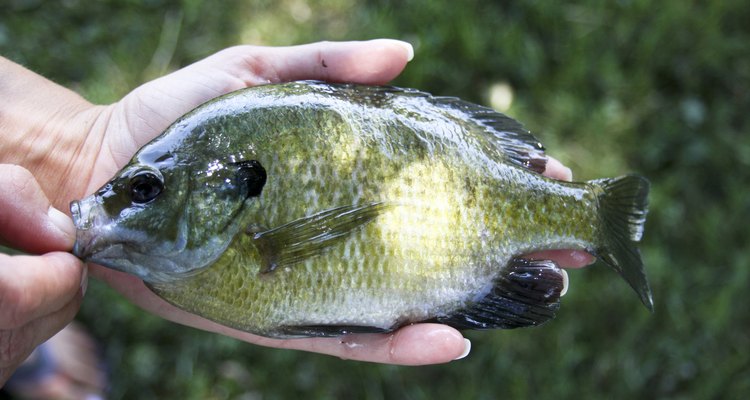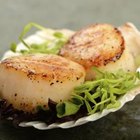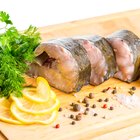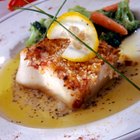
dave willman/iStock/Getty Images
Long, lazy hours spent at the local fishing hole live on as a cherished part of childhood in much of the country, and fixing the day's catch often presents novice cooks with their first culinary adventure. You’ll find bluegills and other panfish easy to cook and very versatile. They're typically fried -- hence the term "panfish" -- but their mild white flesh lends itself equally well to most fish recipes.
Fire Up the Oil
Frying is the iconic preparation method for bluegill, because it's both simple and very, very tasty. For the simplest version, just dredge your fillets lightly in flour and then fry them in a medium-hot skillet with a little oil. If you like them breaded, take it a step further and dip the floured fish in milk, then crumbs. Some cooks dip in eggs and then crumbs, which works equally well. Breaded bluegills can also be deep-fried, or you can dip them in batter instead. Like any fish, bluegill tastes best when deep-fried at about 360 degrees Fahrenheit.
Heat Up the Oven
For a similar flavor with less added fat, you can also prepare your bluegills in the oven. Arrange your fillets on a parchment-lined baking sheet, skin-side down, and brush or spray them lightly with oil. Season them with salt and pepper or fresh herbs, and bake them for 10 to 15 minutes until the thickest part of each fillet begins to be translucent. Breaded bluegill will take a few minutes longer, while bluegill baked under a sauce or salsa can take 25 to 30 minutes. They can also be baked whole, for a more visually interesting presentation.
Set Up a Pot
Steaming and poaching result in a very different meal, leaving the bluegills' own delicate flavor front and center. The French prepare a fish-poaching liquid -- "court-bouillon" -- by simmering onions, peppercorns, bay leaves and other aromatics in water with wine or vinegar. Fish broth, milk or plain old salted water will also work. Bring the liquid to a simmer, slide in your bluegill fillets, and poach them for six to eight minutes until firm. To steam the fillets, arrange them loosely in your steamer and cook them for eight to 10 minutes. Rest them on a bed of aromatics, Asian-style, if you wish to infuse a different flavor.
Gas Up the Grill
Grilling your bluegills provides the savory flavors of high-heat cooking, while still keeping your use of fat to a minimum. Skin-on fillets are less likely to break on the grill than skinless, and even whole fish can be grilled successfully. Clean and oil your grill before you start, and brush or spray the bluegills lightly with oil. Lay them skin-side down on the grill and cook until the line of visibly cooked flesh reaches halfway, then flip them carefully to finish. A mesh fish-grilling basket reduces the risk of breaking your fillets while turning them and is especially useful if you're grilling delicate, skinless fillets.
Related Articles

How to Cook Kingklip

How to Cook Calamari in the Oven

Can You Eat the Skin on Grilled Trout?

Good Ways to Season & Cook Unbreaded ...

How to Cook Panfish in the Oven

The Best Ways to Cook Scallops
How to Steam Mahi Mahi Fillets

How Long & What Temperature Is It to ...

How to Cook a Fresh Perch

How to Cook Sturgeon Fillets

The Best Ways to Cook Pheasant Breast

How to Cook Amberjack on the Grill
How to Cook Whiting in the Oven

How to Cook Stingray
How to Cook Seasoned Keta Salmon

Cooking Frozen Swai Fillets

Can You Bake Wonton Wrappers Instead of ...
The Best Way to Cook Tilefish

How to Cook Monchong Fish

How to Pan Fry Sea Bass
References
Writer Bio
Fred Decker is a trained chef and prolific freelance writer. In previous careers, he sold insurance and mutual funds, and was a longtime retailer. He was educated at Memorial University of Newfoundland and the Northern Alberta Institute of Technology. His articles have appeared on numerous home and garden sites including GoneOutdoors, TheNest and eHow.
Photo Credits
dave willman/iStock/Getty Images